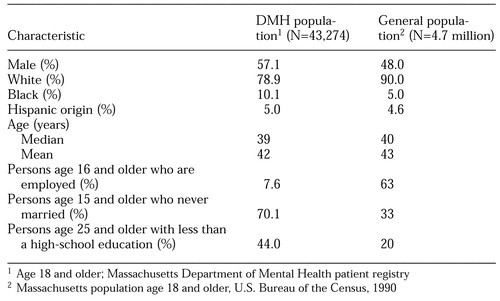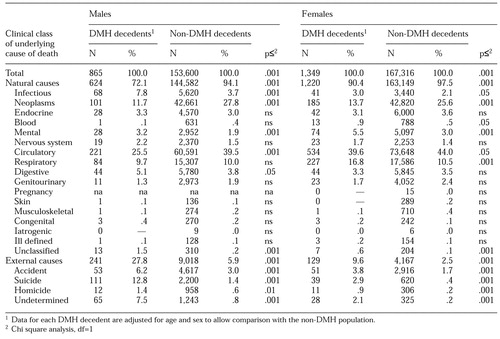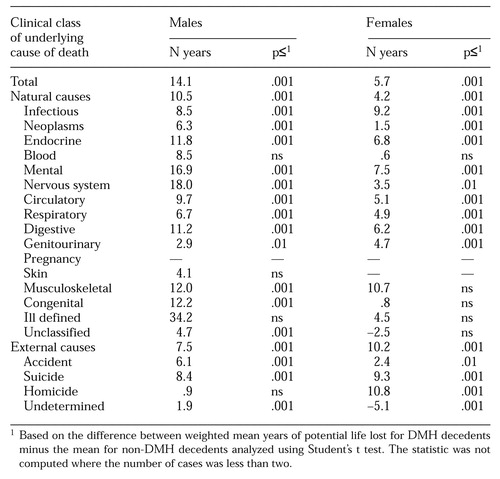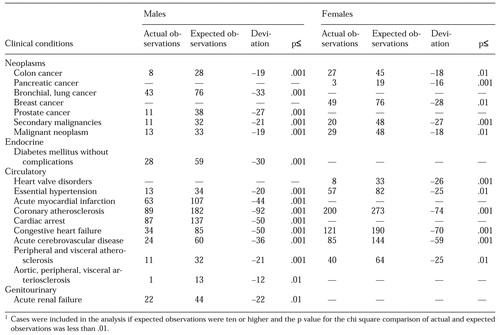Life Expectancy and Causes of Death in a Population Treated for Serious Mental Illness
Abstract
OBJECTIVE: This cross-sectional mortality linkage study describes the prevalence of specific fatal disease and injury conditions in an adult population with serious mental illness. The large sample of decedents and the use of multiple-cause-of-death data yield new clinical details relevant to those caring for persons with serious mental illness. METHODS: Age-adjusted frequency distributions and years of potential life lost were calculated by gender and causes of death for persons in the population of 43,274 adults served by the Massachusetts Department of Mental Health who died between 1989 and 1994. Means and frequencies of these variables were compared with those for persons in the general population of the state who did not receive departmental services and who died during the same period. RESULTS: A total of 1,890 adult decedents served by the department of mental health were identified by electronic linkage of patient and state vital records. They had a significantly higher frequency of deaths from accidental and intentional injuries, particularly poisoning by psychotropic medications. Deaths from cancer, diabetes, and circulatory disorders were significantly less frequently reported. On average, decedents who had been served by the department of mental health lost 8.8 more years of potential life than decedents in the general population—a mean of 14.1 years for men and 5.7 for women. The differential was consistent across most causes of death. CONCLUSIONS: Findings in this study are consistent with previous findings identifying excess mortality in a population with serious mental illness. The high rate of injury deaths, especially those due to psychotropic and other medications, should concern providers.
Researchers and health professionals have long observed that psychiatric patients have reduced life expectancy (1,2,3,4,5,6,7,8,9,10,11,12,13,14,15,16,17,18). Controlled studies of patient populations have quantified this risk in the United States and abroad, and the reported standardized mortality ratio—the ratio of deaths in the patient population to the number that would be expected in the general population—has ranged from 1.7 to 5 (3,4,5,6,7,8,9,10,11,12). Studies of general populations have also confirmed the increased risk of death associated with serious mental illnesses, especially schizophrenia, major affective disorder, and substance use disorders (13,14,15,16,17).
Recently Felker and associates (18) reviewed mortality and morbidity findings and recommended development of models of primary care specific to psychiatric patients. However, samples in studies to date have typically been too small to guide such development in any detail. The last large-scale published study of mortality in the United States analyzed 331 deaths among 5,412 patients admitted to a single facility between 1972 and 1981 (6). None have examined data on multiple causes of death, which have been available in all states only since 1989.
The study reported here used a cross-sectional survey of an administrative patient registry linked electronically to vital records to provide data on deaths over the six-year period from January 1989 through December 1994. The study objectives were to update findings on the mortality of persons with serious mental illness and to provide greater detail on causes of excess mortality. The findings were intended to focus on specific health risks likely to be encountered by primary care and mental health professionals treating the most disabled populations.
Methods
Study design and data sources
The Massachusetts administrative patient registry was linked electronically to vital records for 43,274 persons age 18 and older who used inpatient, residential, or case management services of the State Department of Mental Health (DMH) between July 1985 and October 1994. To be eligible for these intensive services, a person needed to have a diagnosis of at least one "serious or long-term mental illness" other than mental retardation or substance abuse, although these disorders may also have been present. In addition, there must have been evidence of serious dysfunction, such as a risk of danger to self or to others or the inability to care for oneself as a result of the mental disorder (19,20,21).
Data for inpatients were entered into the patient registry starting in July 1985, and data for patients receiving residential and case management services were added beginning in 1988. Cases were included in the study whether or not the individuals continued to receive services from the department of mental health over the study period. In about 45 percent of cases the primary diagnosis was schizophrenia or schizoaffective disorder, and 37 percent of the sample had a major affective disorder. This breakdown of diagnoses was based on internal agency reports. However, because treatment diagnoses were not uniformly available at the time of this study, we did not analyze mortality by psychiatric disorder.
Death certification and vital records linkage
Each state maintains electronic records of all deaths occurring within the state. The records originate with the U.S. Standard Certificate of Death and include data on place of death, whether an autopsy was performed, and the presence of up to 20 medical conditions originally noted by a certifying physician. Medical conditions are reviewed by state nosologists and coded in standard ICD-9-CM nomenclature, after which records are subjected to electronic editing to remove duplicate or invalid codes and to assign a single underlying cause of death (22,23). The underlying cause is the condition judged, in the context of all valid contributing causes, to have initiated morbid events leading ultimately to death.
The DMH registry was electronically matched with state death files for the six-year period from January 1989 through December 1994. Access to patient records by the first author was authorized by the department's institutional review board for the protection of human subjects for matching purposes only. Matching was based on iterative comparisons of names, sex, birth dates, and Social Security numbers, followed by manual inspection of complete records to eliminate false positives. All personal identifying data were removed from the resulting analytic files.
Coding of cause of death
One data file based on underlying cause of death was created, with one record per decedent (N=322,806). A second file containing one record for every mentioned condition was also created. This file therefore contained more than one record per decedent when multiple causes of death were reported (N=819,588). Codes for cause of death were grouped using the Clinical Classification for Health Policy Research (24), a system that combines all ICD-9-CM codes into 18 broad classes and 260 clinically related conditions. The classification was expanded to include ICD-9-CM E codes, which are used when the underlying cause of death is injury. E codes specify the manner in which an injury occurred—accident, suicide, homicide, and undetermined—while the nature of the injury, such as poisoning, is captured by codes already included in the classification.
Life expectancy
To provide a measure of relative excess mortality, we estimated years of potential life lost relative to current life expectancy for each decedent. Unlike life expectancy at birth, which does not change, current life expectancy is the mean survival age for a living cohort of each age and sex. Years of potential life lost is thus always a positive value and approaches zero at advanced age. This method has been used routinely by the Centers for Disease Control and Prevention (CDC) since 1982 to report the relative burden of disease and injury (25). Various methods of measuring years of potential life lost have been adopted as alternatives to standardized mortality rates to assess the impact of specific causes of death (26,27). For this study the number of years of potential life lost was derived for each decedent based on current life expectancy in the U.S. in 1992 (28).
Age adjustment
The state's non-DMH population was used as the standard for comparison of expected frequencies and years of potential life lost. Because the living DMH and non-DMH populations have different age and sex distributions, valid comparisons could not be made without adjusting for this difference. Data for the DMH population were standardized following the direct standardization procedure recommended by CDC (29). Age and sex distributions for the total Massachusetts population from the 1990 census were used to approximate the non-DMH population in the following formula. Analysis weights were computed for each decedent served by the department of mental health asW=PGP/PDMH
where W is the final analysis weight for each DMH case by age and sex, PGP is the proportion of the total state population for each age and sex, and PDMH is the proportion of the total DMH population for each age and sex. For example, young adults and males—groups that are overrepresented in the DMH population—received weights of less than one, while females and the aged received weights greater than one. The weights were applied to the data for each decedent in the DMH population and used in all analyses reported in the results section.
Statistical analysis
SAS software was used to calculate expected frequency distributions and derive associated chi square values and significance levels by cause of death (30). SUDAAN software was used to compute weighted differentials for mean years of potential life lost and associated t test values and significance levels for each cause-of-death group (31).
Results
Patient characteristics
Table 1 shows characteristics of the living population of persons served by the DMH and the living general population before the data were adjusted for age and sex. Adjustment corrected for the dominance of males in the DMH population and for any underlying differences in the age distributions; however, differences in employment, marital status, and education remained.
A total of 1,890 persons served by the DMH and 320,916 persons in the non-DMH general population age 18 and older were identified in death records for the six-year period from 1989 through 1994. After the data were adjusted, the weighted total for the DMH population was 2,214. The median age at death was 66 years for the DMH population and 76 for the non-DMH population. DMH decedents were slightly less likely to die in a hospital than decedents in the non-DMH population—49 percent versus 51 percent, not a significant difference—but were much more likely to have an autopsy (26 percent compared with 10 percent, 2=742, df=1, p<.001).
The average number of conditions that were reported to contribute to death was approximately the same for each group at 2.5 per death. Mental disorders were reported as a contributing cause for 19.1 percent of the deaths of persons served by the DMH (N=423) and 8 percent of the deaths in the non-DMH population (N=25,502) (2=370, df=1, p<.001). Among suicides, mental disorders were reported in only 6 percent of DMH deaths and 4 percent of non-DMH deaths.
Underlying cause of death
The distribution by sex and underlying cause of death for each person is shown in Table 2. DMH decedents had a disproportionately high frequency of deaths from external causes, which include accidents, homicides, suicides, and unexplained injuries. The proportion of males in the DMH population with an external cause of death was almost six times higher than the proportion of males in the non-DMH population with an external cause of death (27.8 percent compared with 5.9 percent, (2=688, df=1, p<.001). For females served by the department of mental health, the proportion of deaths from external causes was nearly four times that for females in the non-DMH population (9.6 percent compared with 2.5 percent, (2=270, df= 1, p<.001).
Males in the DMH population also had a significantly higher frequency of deaths from infectious and digestive disorders and a significantly lower frequency of deaths from neoplasms and circulatory disorders than males in the non-DMH population. Females in the DMH population were significantly more likely to die from infectious and respiratory disorders and significantly less likely to die from neoplasms and circulatory disorders compared with females in the non-DMH population.
Table 3 summarizes differentials in years of potential life lost by underlying cause of death. Overall, the difference in means between decedents served by DMH and others was 8.8 years (t=65.5, df=1, p<.001). Differentials in years of potential life lost were positive for males and females across all causes of death for which the comparisons were statistically significant. For males in the DMH population, external causes accounted for 39.3 percent of the aggregate years of potential life lost, compared with 13.6 percent for males in the non-DMH population. For females in the DMH population, external causes accounted for 19.1 percent of aggregate years of potential life lost, compared with only 5.3 percent for females in the non-DMH population.
Multiple causes of death
Multiple causes of death are all conditions judged to have contributed to death and reported on the death certificate. Among the 1,890 DMH decedents, a total of 5,577 conditions were mentioned, and 814,011 conditions were mentioned for 320,916 non-DMH decedents. Tables 4 and 5 show conditions reported in the DMH population at significantly higher or lower rates than expected. Chi square statistical significance was based on the hypothesis of homogeneity of the DMH and non-DMH populations. Table 4 shows conditions overrepresented in the DMH population with ten or more observed mentions and a statistical significance of <.01. Table 5 shows conditions underrepresented in the DMH population with ten or more expected mentions and a statistical significance of <.01.
To further test the significance of underrepresented conditions shown in Table 5, we compared separately only cases in which death occurred in hospitals or in which autopsies were performed, circumstances where disease conditions were more likely to be detected. The overall pattern in DMH and non-DMH cases remained, with significantly fewer neoplasms and circulatory disorders among DMH decedents.
Discussion
Our purpose was to describe causes of death that distinguish a contemporary population of persons with serious mental illness from the general population. We did not set out to isolate the excess mortality specifically attributable to particular psychiatric disorders, or to establish the precise causal link between mental disorders and early death. We did not address the prevalence of nonfatal illnesses, which may have a profound impact on the quality of a life but are not captured on death certificates.
Our results are relevant to similar populations in other states, but may not apply to all persons with serious mental illness. Populations served by state mental heath departments share several characteristics associated with early death among those who never married, lived in poverty, were poorly educated, smoked, and lived in urban areas (32,33,34). The interaction of mental illness with these risk factors accounts for some of the results shown here. Populations who were never treated, or who received care entirely in other systems such as the Department of Veterans Affairs or the private sector, may show different outcomes.
The inclusion of an entire DMH registry eliminates sampling error, but other measurement error is possible. Undercounting deaths in the DMH population could have occurred from inconsistencies in names or other key identifiers used in matching, and deaths out of state were not included. We assume these errors do not bias the general findings.
We have described excess mortality in a population of persons with serious mental illness in three ways: frequency of the underlying cause, frequency of multiple-cause conditions, and differential life expectancy. We found high frequencies of deaths due to HIV, alcohol-related disease, and injuries as well as reduced life expectancy across all disease and injury conditions in the DMH population. The high rates of intentional and unintentional poisonings are an area of obvious concern to those who care for this population.
Tables 4 and 5 are derived from data on multiple contributing causes of death. As a new fruit of a methodological advance, these data are important, but they are challenging to interpret. For instance, respiratory disorders are overrepresented in DMH women, but not in DMH men. Similarly, diabetes mellitus without complications, while not significantly different in women, is underrepresented in DMH men—an observation that goes against most clinical experience.
Reduced life expectancy may partly explain conditions underrepresented in the DMH population, as early death would precede the emergence of cancer and circulatory disease, which generally occur at later ages. Additional studies would help determine if underreporting of these conditions is due to inadequate detection or a true low prevalence.
Undetermined causes of death—injuries which cannot be positively judged as accidental or intentional—are remarkably high in the DMH population, even though 88 percent of such deaths were followed by autopsies. This category of undetermined causes of death has not been addressed in previous studies. Medical examiners, aided by circumstantial data from families, health care providers, and others, are able to successfully classify most injury deaths. Consequently, undetermined deaths are very rare in the general population. Such deaths reflect the social isolation and lack of medical care that place seriously mentally ill populations at risk, and reduction in the rate of these deaths would be a potential indication of improvement in these risk factors.
Of special note are rates of mental disorders reported as contributing to death. This rate for DMH decedents was more than twice that among the non-DMH decedents. Yet for this population, selected entirely for the presence of severe and disabling mental illness, we believe the death records understate the impact of these disorders. The low rates of mental disorders reported among suicides suggest this understatement is true for both the DMH and non-DMH populations. Mental health providers are not likely to have direct knowledge of patient deaths, which generally occur outside their settings or after care has ceased. Conversely, medical caregivers and death certifiers may be unaware of a history of mental illness. Even when they are aware, they may not associate a mental illness with medical conditions and subsequent death. Taken together these factors would tend to understate the effects of serious mental illness on life expectancy from death records alone.
Conclusions
The reduced life expectancies and mortality differentials reveal a health gap faced by those with serious mental illnesses. Specific causes for this gap could be identified through additional studies from other states with large patient registries that would permit multivariate analyses. Death certification is broadly available in electronic form, making large-scale studies using record linkage more feasible than in the past. The method of analysis using years of potential life lost is replicable wherever patient registries can be linked to state death records. Comparing results across mental health systems may reveal whether variation in resource levels, insurance benefits, or the organization of care can explain variation in life expectancy and cause of death.
Acknowledgments
This work was funded by grant P50-MH-49173-4A1 from the National Institute of Mental Health and by National Research Service Award MH-19292-04 through the National Association of State Mental Health Program Directors. The authors thank David Swanson, Ph.D., for assistance with methodological issues related to the measurement of life expectancy and Mark S. Amorosino, M.A., and Marian Styles for additional assistance.
Dr. Dembling is senior research scientist and Dr. Chen is psychiatric research scientist with the Southeastern Rural Mental Health Research Center of the University of Virginia, Box 393, Health Sciences Center, Charlottesville, Virginia 22908 (e-mail, [email protected]). Dr. Vachon is professor in the department of psychiatry at Boston University School of Medicine.
 |
Table 1. Characteristics of the population of adults served by the Massachusetts Department of Mental Health (DMH) between July 1985 and October 1994 and of the general Massachusetts adult state population in 1990
 |
Table 2. Clinical classes of underlying cause of death among male and female decedents age 18 and older served by the Massachusetts Department of Mental Health (DMH) and in the non-DMH population, 1989-1994
 |
Table 3. Difference in mean years of potential life lost by clinical class of underlying cause of death among male and female decedents age 18 and older who were served by the Massachusetts Department of Mental Health (DMH), 1989-1994
 |
Table 4. Clinical conditions significantly overrepresented among multiple causes of death of male and female decedents served by the Massachusetts Department of Mental Health1
 |
Table 5. Clinical conditions underrepresented among multiple causes of death of male and female decedents served by the Massachusetts Department of Mental Health1
1. Esquirol E, Hunt EK (trans): Mental Maladies: A Treatise on Insanity. Philadelphia, Lea & Blanchard, 1845Google Scholar
2. Malzberg B: Life tables for patients with mental disease. Mental Hygiene 16:465-480, 1932Google Scholar
3. Babigian HM, Odoroff CL: The mortality experience of a population with psychiatric illness. American Journal of Psychiatry 126:470-480, 1969Link, Google Scholar
4. Tsuang MT, Woolson RF: Mortality in patients with schizophrenia, mania, depression, and surgical conditions: a comparison with general population mortality. British Journal of Psychiatry 130:162-166, 1977Crossref, Medline, Google Scholar
5. Eastwood MR, Stiasny S, Meier HMR, et al: Mental illness and mortality. Comprehensive Psychiatry 23:377-385, 1982Crossref, Medline, Google Scholar
6. Black DW, Warrack KR, Winokur G: Excess mortality among psychiatric patients: the Iowa record-linkage study. JAMA 253:58-61, 1985Crossref, Medline, Google Scholar
7. Martin RL, Cloninger CR, Guze SB, et al: Mortality in a follow-up of 500 psychiatric outpatients: part I. total mortality. Archives of General Psychiatry 42:47-54, 1985Crossref, Medline, Google Scholar
8. Allebeck P: Schizophrenia: a life shortening disease. Schizophrenia Bulletin 15:81-89, 1989Crossref, Medline, Google Scholar
9. Newman SC, Bland RC: Mortality in a cohort of patients with schizophrenia: a record linkage study. Canadian Journal of Psychiatry 36:239-45, 1991Crossref, Medline, Google Scholar
10. Mortensen PB, Juel K: Mortality and causes of death in first-admitted schizophrenic patients. British Journal of Psychiatry 163:183-189, 1993Crossref, Medline, Google Scholar
11. Sharma R, Markar HR: Mortality in affective disorders. Journal of Affective Disorders 31:91-96, 1994Crossref, Medline, Google Scholar
12. Segal SP, Kotler PL: A ten-year perspective of mortality risk among mentally ill patients in sheltered care. Hospital and Community Psychiatry 42:708-713, 1991Abstract, Google Scholar
13. Corten P, Ribourdouille M, Dramaix M: Premature death among outpatients at a community mental health center. Hospital and Community Psychiatry 42:1248-1251, 1991Abstract, Google Scholar
14. Bruce ML, Leaf PJ, Rozal GPM, et al: Psychiatric status and 9-year mortality in the New Haven Epidemiologic Catchment Area study. American Journal of Psychiatry 151:716-721, 1994Link, Google Scholar
15. Hibbs JR, Benner L, Klugman L, et al: Mortality in a cohort of homeless adults in Philadelphia. New England Journal of Medicine 331:304-309, 1994Crossref, Medline, Google Scholar
16. Berren MR, Hill KR, Merikle E, et al: Serious mental illness and mortality rates. Hospital and Community Psychiatry 45:604-605, 1994Abstract, Google Scholar
17. Kouzis A, Eaton WW, Leaf PJ: Psychopathology and mortality in the general population. Social Psychiatry and Psychiatric Epidemiology 30:165-170, 1995Crossref, Medline, Google Scholar
18. Felker B, Yazel JJ, Short D: Mortality and medical comorbidity among psychiatric patients: a review. Psychiatric Services 47:1356-1363, 1996Link, Google Scholar
19. Admissions Criteria to DMH Inpatient Facilities. MDMH policy memo 88-4. Boston, Massachusetts Department of Mental Health, Sept 23, 1988Google Scholar
20. Establishing Eligibility Criteria for DMH Priority Clients. MDMH policy memo 89-3. Boston, Massachusetts Department of Mental Health, Oct 31, 1989Google Scholar
21. Interpretive Guidelines: Determining Eligibility for DMH Continuing Care Services Under Policy 89-3. Revision to MDMH policy memo 89-3. Boston, Massachusetts Department of Mental Health, Sept 1, 1996Google Scholar
22. ICD-9 ACME decision tables for classifying underlying causes of death, part 2c, in Instruction Manual for Classifying the Underlying Cause of Death. Hyattsville, Md, National Center for Health Statistics, 1991Google Scholar
23. ICD-9 TRANSAX disease reference tables for classifying multiple causes of death, part 2f, in Instruction Manual for Classifying the Multiple Causes of Death. Hyattsville, Md, National Center for Health Statistics, 1991Google Scholar
24. Clinical Classifications for Health Policy Research, Version 2: Hospital Inpatient Statistics. AHCPR pub no 96-0017. Rockville, Md, US Department of Health and Human Services, Agency for Health Care Policy and Research, Feb 1996Google Scholar
25. Perspectives in disease prevention and health promotion: premature mortality due to unintentional injuries: United States, 1983. Morbidity and Mortality Weekly Report 35(22):353-356, 1986Google Scholar
26. Gardner JW, Sanborn JS: Years of Potential Life Lost (YPLL): what does it measure? Epidemiology 1:322-329, 1990Google Scholar
27. Murray JL, Lopez AD (eds): The Global Burden of Disease: A Comprehensive Assessment of Mortality and Disability From Diseases, Injuries, and Risk Factors in 1990 and Projected to 2020. Geneva, Switzerland, World Health Organization, 1996Google Scholar
28. Vital Statistics of the United States, 1992: Life Tables, Volume II, Section 6. PHS pub 96-1104. Hyattsville, Md, National Center for Health Statistics, April 1996Google Scholar
29. Curtin L, Klein, RJ: Direct standardization (age-adjusted death rates), in Statistical Notes. PHS pub 95-1237. Hyattsville, Md, National Center for Health Statistics, March 1995Google Scholar
30. SAS/STAT User's Guide, Version 6, 4th ed, vol 1. Cary, NC, SAS Institute, 1989Google Scholar
31. Shah BV, Barnwell BG, Bieler GS: SUDAAN User's Manual, Release 7.0. Research Triangle Park, NC, Research Triangle Institute, 1996Google Scholar
32. McGinnis JM, Foege WH: Actual causes of death in the United States. JAMA 270:2207-2212, 1993Crossref, Medline, Google Scholar
33. Smith MH, Anderson RT, Bradham DD, et al: Rural and urban differences in mortality among Americans 55 years and older: analysis of the National Longitudinal Mortality Study. Journal of Rural Health 11:274-285, 1995Crossref, Medline, Google Scholar
34. Geronomus AT, Bound J, Waidmann TA, et al: Excess mortality among blacks and whites in the United States. New England Journal of Medicine 335:1552-1558, 1996Crossref, Medline, Google Scholar
35. Carney CP, Yates WR, Goerdt CJ, et al: Psychiatrists' and internists' knowledge and attitudes about delivery of clinical preventive medical services. Psychiatric Services 49:1594-1600, 1998Link, Google Scholar



